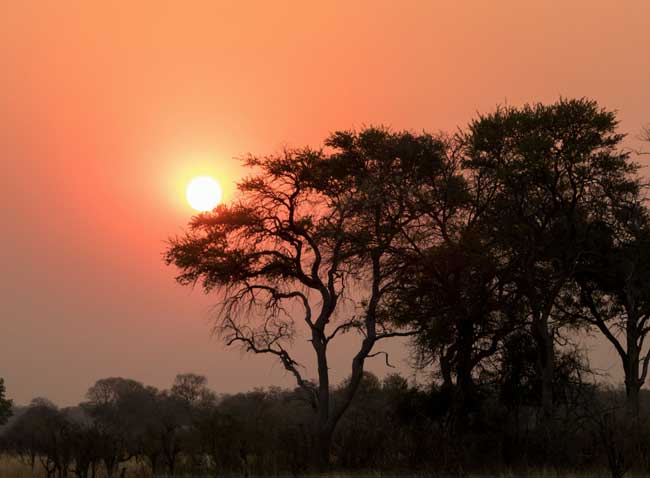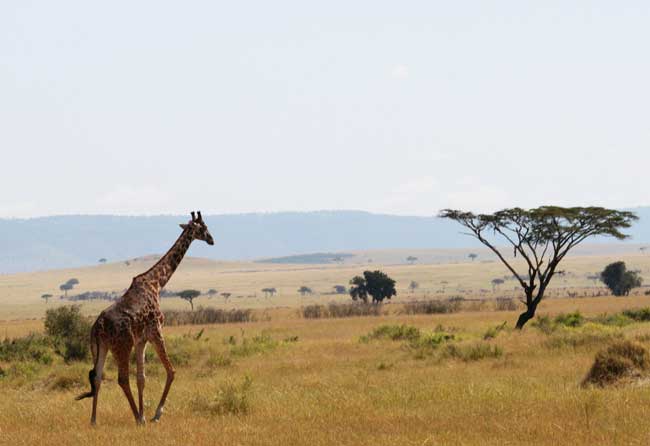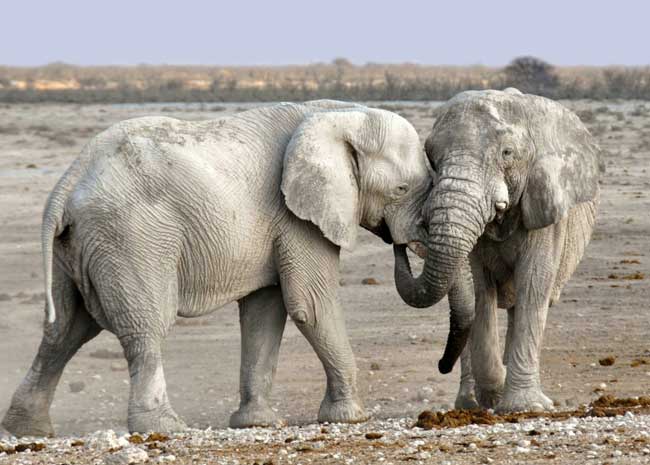
 How tourists dress when they visit Africa is a source of amusement to me, a local. I figure someone is making a bundle, sending them to the same outdoor adventure outlet to buy the same kit. I Googled a few articles and a couple of them recommended not sticking out like a sore thumb. Well, being part of a gaggle of folk dressed more game rangerish than a game ranger, albeit in brand new Columbia (insert your brand here) gear, won’t work.
How tourists dress when they visit Africa is a source of amusement to me, a local. I figure someone is making a bundle, sending them to the same outdoor adventure outlet to buy the same kit. I Googled a few articles and a couple of them recommended not sticking out like a sore thumb. Well, being part of a gaggle of folk dressed more game rangerish than a game ranger, albeit in brand new Columbia (insert your brand here) gear, won’t work.
Guides wear heavy duty stuff because they do heavy duty stuff, day in and day out. They don’t just drive guests around.
 What to Wear When Traveling in Africa
What to Wear When Traveling in Africa
Trust me, unless you are roughing it or going on walking safaris, you really don’t need half the stuff. Most people, visiting lodges, do less exercise than normal. Typically, you walk to a central point for a pre-game drive coffee, then sit for hours in a vehicle, disembark, eat, relax, repeat.
You can very quickly put on weight.
My recommendations? Light, layers, comfortable. I pack lightweight cotton clothes (fancy wicking safari gear is ok too). Stuff that dries quickly and can pack small. I read somewhere that Africa can be “quite warm,” like 30C or so. Actually, think 40 or 50C. Think extreme humidity in many cases, which pushes the “real feel” up by 10 or more degrees.

In summer, I’m usually in a t-shirt, shorts and slip slops (sturdy ones with a hard, grippy sole.) Surfer or skater brands are best in my opinion, not just for slops. The clothing is well designed — comfortable, stylish, well made, and it lasts. And you look normal, so you can wear it back home and on your tropical island vacation, whereas your safari gear, well, not so much.
Shoes? Wear something comfortable, with good soles. My skateboard sneakers have phenomenal grip. As mentioned earlier, most people do way less walking than expected. Of course, you can bring your entire gym kit (there’s often a gym or mountain bikes).
A snug fitting cap is essential for me (I’m pretty bald), but wide brimmed hats and others are not, because they are more likely to blow off when your game vehicle or boat picks up speed and they are harder to pack.
 Other Travel Tips in Africa
Other Travel Tips in Africa
Sunglasses are essential, and ALL sunglasses should be polarized in my opinion, though they can be a pain when you try to view a polarized camera screen through 90 degrees. The glare here can be intense and, on an all-day outing in an open game vehicle, or on a boat, sunnies also keep bugs out of your eyes.
Regarding sunblock: I use a factor 50 spray that dries instantly, is non- greasy and doesn’t stain clothes (as much) when mixed with sweat and dust. Bear in mind that you’re likely to find sunblock and insect repellent in your room at the better lodges.
I have a lightweight Nike windbreaker with a hood that goes everywhere with me. It can fit in my camera bag and is a couple of shades of grey. Neutral colors on outer layers are important in the wild. I’ve read that it’s so you don’t scare the game. Nah. It’s so you don’t attract unwelcome attention, especially if you are walking and come across lions/ellies/rhinos.

What to Wear in Winter
In winter, things change. Those early morning game drives? With the wind chill factor, sub-zero temperatures are a thing, even if it’s mid 20s (Celsius) later. I’ve packed too light in the past and ended up with pneumonia.
Boots/windproof footwear and long socks for me please, plus long pants, t-shirt, light sweater, fleece, windbreaker, beanie. A kikoi or scarf is good, and sometimes I take a snowboard jacket, though it’s bulky. The extra length at the back keeps the cold wind out. Most game drive vehicles have blankets or, better, lined ponchos with hoods, and sometimes hot water bottles.
Those layers are important because it warms up (or cools down), so you are likely to be adding and subtracting a fair bit. A 3-in-1 jacket is recommended.
Dressing up for dinner is largely an optional extra (game drives often return just in time for dinner or depart straight after). So too is raingear for the most part (once again, unless you’re roughing it or chasing gorillas in rain forests). Any decent lodge will provide umbrellas and ponchos.
 What to Pack When Traveling to Africa
What to Pack When Traveling to Africa
There are few things worse than being in a beautiful place in a foreign country but being really ill. I’ve had the displeasure on several occasions. Food poisoning, sunstroke for lily white Caucasians, sub-tropical bugs — there is plenty to take the wind out of your sails.
I have some travel essentials. Whatever your view on antibiotics, I travel with them. Tavaloxx 500 is what I have now for an upcoming Madagascar trip. I’m always dishing out Valoid (anti-nausea) to fellow travelers, though I’ve not ever had one myself. I also take charcoal tablets and probiotics, Texa (anti-histamine), eye drops, plasters (Band-aids) and antiseptic cream. Dental floss is extremely handy too. It’s been keeping a few buttons in place and my lens cap attached to my camera for years. And yes, lip balm, lip balm, lip balm.
I SCUBA dive and Flonase nasal spray and Texa are a good combo for my sometimes-troublesome ears, as is a hit of Iliadin just before a dive. Brand names may differ around the globe.
I also have mild sleeping tablets. Often the first night in a new place can be a restless one. And, if my back or buggered knees are aching after a long journey, a sleeping tablet solves a few things.

Nail clippers come in handy. A universal adaptor plug is a must. A torch (or as the Americans call it, a flashlight), not so much. I use my cellphone. There are always candles and matches in your room and, if you are with a guide, he or she is sure to have lighting.
You’ll also want something to clean sunnies, specs and camera lenses. Always.
Luggage (safety and security)
In-room safes are almost always provided. I hardly ever use them, and have been criticized by many for being careless, but theft is rare at resorts or far flung places. I always travel with camera, laptop and cellphone and have only once had anything go missing – my camera on an island off Mozambique. Long story short, it was couriered to me.
Where things do go missing is airports, with OR Tambo in Johannesburg being particularly notorious. I have had my luggage broken into and stuff stolen. I have also had my luggage broken. My luggage preference is a hard-shell suitcase with no zips. It’s a bit heavier perhaps, but breaking into it would take time and effort. It’s also a four-wheeler, as is my smaller, soft bag. It makes a difference to me, getting around airports, and I hardly ever use a trolley.

A backpack is always required. Waterproof is a nice to have but I make do with my Targus laptop bag after my Bangkok North Face knock off eventually died. It has plenty of compartments.
If you are not an overseas tourist, or not restricted by airline regs, don’t skimp. When I drive somewhere I take pillows and if I have a car, I’ll fill it.
On the subject of vehicles – if you are game viewing, I strongly recommend going on a guided game drive. You will see and learn so much more than on a self-guided drive as field guides know how and where to look and often have very localized knowledge. Also, you don’t have to watch where you are going or find your way.
If you are self-driving and headed to a nature reserve, the higher your ride, the more you will see.
In the “green season” (summer/rainy), you will see less game. The grasses are tall, the bush is thick and animals do not rely on waterholes or rivers (viewpoints) for water. If it’s cold and wet, animals lie low. If it’s hot, they lie low in the heat of the day, so first light and late afternoons are best. Big cats typically only stir around sundown unless they are very hungry or already on a kill.
Whatever you’re driving, whatever you’re wearing, have a comfortable trip and I hope you see all (and more) that you wish for.
 Author Bio: For the better part of a decade, Adrian Rorvik has travelled hard and fast, continuously- chasing deadlines for weekly travel features linked to prizes that he arranges as Travel and Leisure Coordinator for Independent Newspapers, South Africa. He now manages Travelogue.tv and Travelogue.africa and still gets about. Not being quite a tourist, or on holiday, affords a different perspective, as does “speed dating” with owners and staff. Like in movies, associations and relationships are accelerated and, in most cases, he gets a peek behind the scenes of the many wonder filled places he has been.
Author Bio: For the better part of a decade, Adrian Rorvik has travelled hard and fast, continuously- chasing deadlines for weekly travel features linked to prizes that he arranges as Travel and Leisure Coordinator for Independent Newspapers, South Africa. He now manages Travelogue.tv and Travelogue.africa and still gets about. Not being quite a tourist, or on holiday, affords a different perspective, as does “speed dating” with owners and staff. Like in movies, associations and relationships are accelerated and, in most cases, he gets a peek behind the scenes of the many wonder filled places he has been.
- Discover Claremont, California Along Historic Route 66 - December 6, 2024
- Three Sites to Soothe the Soul in Kyoto, Japan - December 5, 2024
- 13 Essential Tips For Women Traveling in Morocco - December 4, 2024

 What to Wear When Traveling in Africa
What to Wear When Traveling in Africa What to Pack When Traveling to Africa
What to Pack When Traveling to Africa